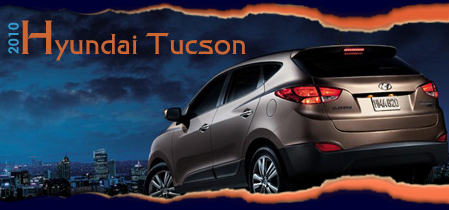|

2010 Hyundai Tuscon New Car Review
by Bob Plunkett
A car-based CUV redesigned for a smooth ride
Pitched in the foothills of the Cascade Range southeast of Seattle, the Washington state route 169 winds through crossroads communities like Maple Valley and Morganville on the way to Black Diamond.
This twisty asphalt strip, rolling over fir-tipped hills and cutting more than a few acute-angled corners, seems like it was designed expressly to show off the road-hugging agility and sticky tire traction of the agile Tucson, Hyundai's crossover utility vehicle for the compact class.
The 2010 Tucson measures 3.3 inches longer and an inch wider than the previous edition, yet its 61 pounds lighter.A generous wheelbase length of 103.9 inches and a wide wheel track of 64.2 inches up front and 62.4 inches in back set up a long and broad foundation for stability when steering through a set of curves.
And, unlike some wagons with a solid rear truck axle and crude leaf springs, Tucson carries four-wheel independent suspension components -- a MacPherson strut-type front suspension with gas-charged hydraulic shocks and stabilizer bar and an independent multi-link design in the rear using coil springs and gas-charged hydraulic shocks and stabilizer bar -- which bring more control over the vehicle for a driver and more comfortable ride sensations for passengers.
As a result, Tucson offers the easy-to-drive manners of a refined sedan.
Tucson also brings a forceful four-cylinder powertrain distributed across two tiers of trim -- the base GLS and deluxe Limited.
And the wagon supports two traction formats for both trims with front-wheel-drive (FWD) or all-wheel-drive (AWD).
The optional electronic AWD system normally directs all power from the engine to the front wheels, thus reducing the fuel consumption. When front wheels slip, however, the device can divert some of the power to turn the rear wheels. A driver-activated locking switch for the center differential fixes the torque split evenly at 50/50 front/rear for tackling slippery dirt trails.
Hyundai packs the 2010 Tucson with a long list of safety gear.
Each trim edition stocks passive safety systems like frontal air bags and seat-mounted side-impact air bags front and rear plus curtain-style air bags above outboard seats on two rows. And Hyundai adds active adjustable head restraints for the front seatbacks.
For active safety, every issue also has a disc brake at every wheel, with electronic linkage to a four-channel anti-lock brake system (ABS) with electronic brake force distribution (EBD), plus hill-start assist control (HSC) and downhill brake control (DBC).
Each Tucson trim also carries an electronic stability control (ESC) device which automatically coordinates the brakes and throttle to check against lateral wheel skidding.
All versions pull from one eco-efficient powertrain.
The dual-cam four-cylinder Theta II engine displaces 2.4 liters and has Hyundai's CVVT (continuously variable valve timing) equipment on both camshafts and VIS (variable induction system) for better engine breathing.
The Tucson GLS edition comes with a standard six-speed manual transmission or optional six-speed electronic automatic rigged with Hyundai's Shiftronic manual mode.
Tucson Limited edition gets the six-speed Shiftronic automatic exclusively.
EPA fuel economy figures reach as high as 31 mpg for highway driving using the automatic transmission, or 28 mpg for highway driving with AWD traction.
Tucson's slick body styling comes out of Hyundai's European design and technical center in Frankfurt, Germany.
Theme for the exterior is a fluidity of lines drawn in rectangular format but with curt prow and radically canted windshield and a tapered canopy over the cabin with narrow windows and side pillars muted to forge the profile of a slinky two-door coupe.
Hyundai labels the design language for Tucson as "Fluidic Sculpture" inspired by nature to produce the illusion of motion from curvy shapes of rigid surfaces.
Still, you can't miss that brash face sporting narrow eye-slit headlamp clusters on front corners flanking a trapezoidal grille with chrome bar and black fins.
Side panels are chiseled with ripples and bulges for the swollen wheel wells fore and aft.
The blunted rump looks clean with a disguised hatchback door, twin-lamp taillight assemblies wrapping around corners and a body-colored bumper swooping low.
Tucson's rigid structure whittles out a rather spacious cabin and a utilitarian cargo bay.
Door sills are set low like the sills on a car so you can slip aboard easily.
Seats are tall so you sit up for good visibility.
Eace cabin layout pitches a pair of bolstered buckets in front flanking a versatile console. On the second row a bench is designed to seat two comfortably but hold three riders if necessary. The seatback splits 60/40 and folds down to expand the cargo area.
The storage area is generous at 25.7 cubic feet but with rear seatbacks folded it expands to 55.8 cubic feet.
It also has under-floor cargo storage with a reversible cover.
Tucson GLS comes with a load of standard equipment, including air conditioning, power controls for windows and door locks and mirrors, a remote keyless entry system with alarm, tilting steering wheel, two power outlets (front and cargo area), bottle holders in all four doors, rear wiper and washer, and an audio system with M/FM/CD/MP3/Satellite Radio and six speakers plus iPod/USB input jacks.
Optional packages load more gear -- Popular Equipment, Navigation, Premium Equipment.
Price points for the 2010 Tucson begin at $18,995 for a GLS FWD M/6. Top model Limited AWD A/6 lists at $25,845. |